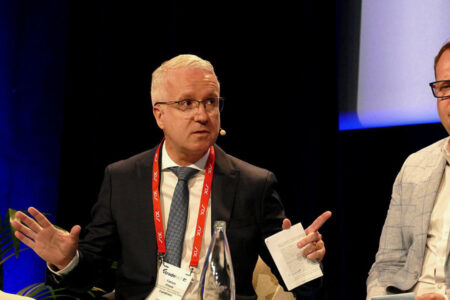Large technologically-powered market makers are increasingly visible in equity markets, and buyside participants praised the liquidity they provide.
Emerging from their secretive prop trading roots, large market making firms have joined the mainstream, either as electronic liquidity providers (ELPs) or systematic internalisers (SIs), according to buyside panellists at TradeTech Europe.
“SIs just offer something that probably some dark multilateral trading facilities (MTFs) do not offer”, said Fabien Oreve, head of trading at Candriam Asset Management. “It’s just immediacy of execution. Sometimes we need to trade as an emergency and SIs offer that liquidity immediately”.

Buyside stakeholders at Tradetech lined up to confirm that the liquidity is both genuine and welcome.
Mike Poole, head of trading at Jupiter Asset Management said, “If you choose the right venue for the right order, counterparty selection and toolbox breadth matter more than any single market‑share statistic.”

Fellow panellist Kavel Patel of BMO Capital Markets supplied further arguments: “Client analytics now show investors will trade on lit books, periodic auctions or SIs so long as price impact is low.”

The panel noted that seven large, non‑bank electronic market‑makers dominate EU equity liquidity provision.
Matt Clarke, head of EMEA distribution at XTX Markets, said, “High infrastructure and capital costs will deter new entrants.”
He noted that the issue is scale, not oligopoly.
“Two sophisticated parties willing to trade define true price; everything else references that,” he said.
Clarke argued that for liquid megacaps the system can tolerate sizeable off‑book prints, whereas thin small‑caps “really do suffer” if on‑exchange volume halves.
The debate also focused on transparency and operations. Anish Puaar, European head of market structure at Optiver reminded regulators that his firm hedges bilateral risk “via correlated stocks, futures, options; that activity returns to screen markets,” warning that blunt caps on bilateral trading could “backfire if they ignore execution quality.”
He also suggested further academic research should take place to uncover the potential impacts of market maker activity on the market.
Buyside delegates, for their part, asked for better post‑trade flags rather than hard venue quotas, a plea repeated by several speakers across the two panels.
For now, the verdict from Europe’s largest asset managers like Candriam and Jupiter is clear: the liquidity SIs and ELPs deliver is visible, addressable and often decisive—especially in stressed markets. Whether that remains compatible with healthy price discovery, panellists agreed, depends less on market‑makers growing dominance than on sharpening pre and post trade data.

Clarke stressed that systematic‑internaliser (SI) activity is large but anything but secret.
“We rely on lit exchanges for price formation, but bilateral SI flow is exploding — north of €1 billion a day for us,” he said, adding that the venue’s curated streams let traders show size privately without distorting the screen — “block opportunities I can’t show on lit books.”
Market makers insisted that it was all part of a virtuous circle where they could absorb risk across their balance sheets.
According to Optiver’s Puaar, “What we do bilaterally doesn’t affect our on-screen strategies. They’re two distinct things. When we trade bilaterally, the liquidity doesn’t specifically disappear into thin air. We have to manage that position, unwind that risk. That that means for us is that we’ll trade out a position using correlated assets, using the stock itself. We’ll skew our option pricing we’ll provide liquidity and ETFs as necessary. So there’s still a large element of on screen trading related to our bilateral trading”.

